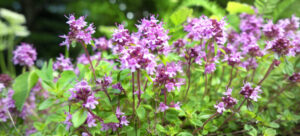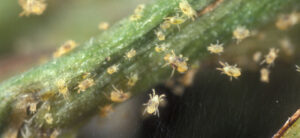
Learning how to get rid of thrips quickly can be the difference between scrapping your plants and salvaging your garden.
Of all the gardening pests you may have to deal with, thrips are some of the most annoying.
Luckily, we have some tips to prevent them in the first place. But even the best prevention measures can render ineffective under certain circumstances.
After we share some prevention tips, we'll help you figure out the best way to get rid of thrips quickly and safely, in hopes of saving your harvest.
First, we need to explain why these insects are bad, and what they can do to your plants, along with how to identify them from other pests.
What Are Thrips?
The full name for a thrip is “Thysanoptera” - but that’s quite a mouthful! These small pests are slender insects with fringed wings. They can be found on both indoor and outdoor plants.
Some thrips feed on other insects and can act as beneficial insects in this manner. They do this by sticking them with their pincers and then slurping out their insides.
That said, many thrips damage the leaves and buds of a plant, leaving behind unhealthy plants that have been sucked of their life.
There are more than 6,000 species of thrips around the world, many of which feed on plant juices, leaves, plant tissues, and flowers.
These common pests can not only kill your plants by feeding on them directly, but they can also spread a variety of plant diseases. They are known to be transmitters of impatiens necrotic spot virus and tomato spotted wilt virus.
Signs An Infestation: How To Identify Thrips

Before you notice any damage to your plants, you might notice the thrips themselves. Adult thrips are tiny - usually, less than 1/25 of an inch - and are colored like straw.
They can also be black. Either way, they will have two pairs of feather-like wings. Often, you won’t notice just one thrip but instead, a grouping clustered together.
This is because thrips feed in large groups and generally leap off plants when they are disturbed.
Thrips can affect just about any kind of plant, but the most common host plants include carrots, onions, squash, beans, roses, and gladioli.
The most obvious signs of a thrip infestation are black specks. These specks are actually the feces from thrips.
You might notice stripped leaves or flowers that die back before they really have a chance to bloom. Even plants that look distorted or damaged in some way can be symptomatic of a thrip problem.
You might find that your plants look discolored, scarred, or twisted. The leaves can become pale or even silvery in color.
Be Sure You're Dealing With Thrips Before Taking Action

It’s important to make sure it’s truly thrips that are damaging your plants (and not another type of creature) before you take steps to eliminate them.
There are certain pests that can cause damage similar to that of thrips, like lace bugs and mites. A popular type of thrip is called the western flower thrip.
Make sure thrips are the problem before you take steps to control them!
You also should make sure the thrips you see are causing problems for your plants. In other words, just seeing a thrip is not necessarily an indicator that you need to destroy it.
How To Prevent Thrips
It's always worth the extra effort to prevent thrips from infiltrating your garden in the first place.
Once they are there, you'll have to be more invasive with your methods for killing them. But, if you do a good job with the prevention, you'll never have to use any sort of sprays.
Here are some of the easiest methods for preventing thrips on your plants in the first place.
Clean Up
The first step in preventing thrips is to avoid attracting them to the garden in the first place. To do this, clean up any plant debris along with any grass and weeds from around the garden area.
Pay special attention to your garden at the end of the growing season. You need to avoid leaving onion leaves behind, in particular, as these are especially attractive to thrips.
You can take things a step further and disinfect pots and throw out old growing media after each growing cycle.
Mind Your Mulch
Mulch is a beneficial tool that many gardeners implement in their gardens. However, it’s important that you use the right kind of mulch. Using green, fresh mulch can attract thrips.
Dry mulch, on the other hand, will not, and can help create a healthy garden that resists thrips instead.
Check All New Plants
If you’re transplanting seedlings or adult plants into your garden, check them thoroughly before you start to dig. We always recommend separating new plants you bring into your garden or grow room for a week or so before introducing them to your existing plants.
Make sure they don’t have any damage or active bugs feeding on them. Infested plants should be discarded by bagging them and putting them in the trash.
Do not compost the plants, as this can spread thrips and the many viruses that these pests can carry.
How To Get Rid Of Thrips
Even the most bulletproof prevention efforts will sometimes fail to keep thrips out. But don't stress. We are now going to teach you how to get rid of thrips on plants quickly and safely.
From simply manually removing the thrips to using an insecticide, we have a wide range of methods you can implement in your garden to restore balance.
Prune Your Plants
Pruning back your plants is one of the easiest ways to deal with thrip damage. This will remove any injured areas of the plant so your plant isn’t spending unnecessary energy on repairing and healing those parts.
It can also get rid of areas that are attractive to the thrips, reducing the likelihood of further damage.
Pruning the flowers and leaves can both be beneficial steps in your efforts to control a thrip problem.
Avoid fully shearing the plant, as this can encourage an onslaught of new growth that will attract hundreds of new thrips.
Use Neem Oil or Natural Plant Soap
You can use neem oil (both organic and synthetic options are available) or plant washes/insecticidal soaps to get rid of your thrips.
There are several safe soaps made out of natural plant oils, like Spinosad, that can knock out heavy infestations in a jiffy. Most won’t harm beneficial insects or animals, either.
You’ll want to pay particular attention to the underside of leaves when you are applying these treatments. Using one of these treatments should eliminate your thrip problem quickly.
Try Sticky Traps
There is some evidence that sticky traps, particularly blue sticky traps, can be helpful in eliminating thrips.
Using blue sticky traps will enable you to closely monitor adult populations so you can keep an eye on the scale of your infestation.
Spray Bugs Off Plants
One of the easiest ways to get thrips off your plants is to spray them with a quick blast of water.
Knock them down a quick blast of cold water - they might not return at all.
Try Diatomaceous Earth
Diatomaceous earth is like tiny shards of glass to insects - but it won’t hurt you, beneficial insects, or other wildlife in the slightest.
Diatomaceous earth is a powder that consists of the fossilized remains of microbes. When soft-bodied insects like thrips move across it, it cuts their bodies and dries them out.
It’s an easy, eco-friendly way to get rid of thrips in the garden. To apply, simply scatter it around the perimeter of your garden or around the specific plants that are being disturbed by thrips.
You may have to reapply regularly, particularly after a rainstorm, for this treatment to be effective.
Another option that is similar to diatomaceous earth is kaolin clay. Kaolin clay is equally eco-friendly and coats the foliage of plants with gritty dust that insects detest.
Release Beneficial Insects
There are several types of beneficial insects that you can introduce to your garden to help with biological control.
You can do this by planting various plants to attract these beneficial insects, or you can purchase them commercially and release them into your garden.
Some options include:
- Orius insidiosus
- Beneficial Nematodes
- Ladybugs
- Lacewings
Many of these insects are effective at destroying thrips at all stages, from egg to adulthood.
Get Rid Of Thrips With Insecticides
If you have a serious infestation, you will likely need to use some sort of insecticide to remedy the issue.
Many of the insect killers we recommend for thrips infestations are OMRI listed and leave behind no residuals in the plant. Here are some of the top pesticides for thrips:
- General Hydroponics AzaMax Concentrate
- Safer Brand 3 in 1 Garden Spray Concentrate (OMRI Listed)
- Fox Farm Force of Nature
If you want to see some other options, check out our article covering the best garden pesticides!
Key Thrips Life Cycle Facts
These insects are often considered pests in gardens, vegetable patches, and houseplants. Knowing about their lifecycle deal with them better.
Adults lay eggs in live plants for them to hatch and give rise to the next generation.
Total lifespan – from egg to death, a single thrips may live up to two months (60 days) if consistently active.
From the moment the egg hatches to a full adult that is capable of reproduction, a thrips will go through several stages.
Final Thoughts On How To Get Rid Of Thrips
In summary, practice good garden hygiene and you may never have to deal with thrips, even if you are growing outdoors.
However, if they do infiltrate your gardens and begin terrorizing your plants, you should act quickly with a number of methods to kill them.
Should you need them, we have a very wide range of solutions to help you eliminate ANY pest from your garden.
Reach our team by phone at 888-815-9763 to answer any questions you have to help you achieve your best results yet.























